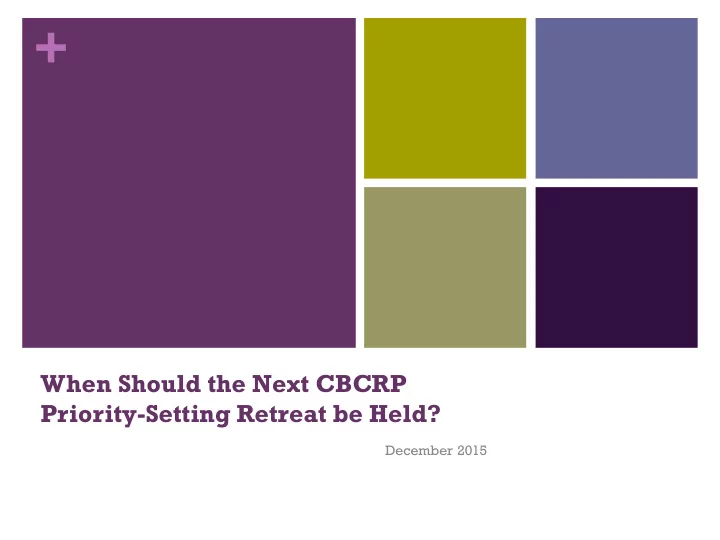

+ When Should the Next CBCRP Priority-Setting Retreat be Held? December 2015
+ Should CBCRP hold the next Priority-Setting Retreat in: 5 years / 2020 7 years / 2022 or 10 years / 2025?
+ Background 2004 Set-aside 30% of research funds for program-directed research into the environmental links to breast cancer and the unequal burden of the disease. Eliminated the following award types: New Investigator, Career Enrichment, Training Program, RFA, Scientific Perspectives Research Collaboration (SPRC)-pilot and full, Translation Research Collaboration (TRC)- pilot and full. 2010 Set-aside 50% of research funds for program-directed research. Continued to focus on environmental links and disparities, and added a focus on prevention (strategies for high-risk individuals and population-level strategies). Eliminated the following award types: Postdoctoral Fellowships, Dissertation. Instituted LOI requirement for IDEAs.
+ Background: (Continued) 2015 The 2015 process took 2 years to implement. Continued 50% set-aside. Continued focus on environment, disparities, and population-level prevention strategies. Eliminated strategies focusing on high-risk individuals. Continued existing award types: Pilot and Full CRCs, Translational Awards, IDEAs, and Conference Awards. Implemented Policy Award.
+ Overview of the Process Five major steps: ① Review the CBCRP mission statement. Make revisions to the mission as deemed necessary. ② Review and revise the program goals, as well as review and revise as necessary the data collection questions corresponding to each program goal. ③ Gather and analyze pertinent data as indicated by the program goals and data collection questions. ④ Identify and make decisions on long-term (5 years) priorities through a data-driven, group decision-making process. ⑤ Incorporate priority decisions into CBCRP operational plans and award cycles.
+ Questions (and Resulting Data) That Committee Considered* 1. When will we need to start? 2. What data will be available? Is it enough? 3. What evaluations are already planned? 4. What data will be captured automatically by the new electronic grants management system? 5. Are there any other significant events planned in the next five years that may provide challenges to implementing priority- setting? 6. Does the field change rapidly enough to warrant a significant review every 5 years? *Please see the attached word document for an in-depth summary of data
+ Potential Timing of Process Retreat Year Process Will Initiate 2020 Early 2018 2022 Early 2020 2025 Early 2023
+ Pro’s 5 Years (2020) Will have evaluation data for Translational awards in 2017. Keeps schedule as it has been. Other BC funders change priorities annually. 7 Years (2022) Will have good amount of funding data for: CRC Full, CRC Pilot, IDEA, Translational, Conference, Policy, SRI, and some data for CBCPI. Will have evaluation data for Translational Awards, and time to conduct evaluations of all other mechanisms. Outcomes data from internal data base will likely be online and helpful. Tech advances likely to facilitate outcome data mining. Parallels the timeframe for Program Initiatives set-aside PI 3.
+ Pros (Continued) 10 Years (2025) Lots of data for evaluating mechanisms, including current PI 3. Internal database to track outcomes online. Time to implement tech advances to cull outcomes from research.
+ Cons 5 Years (2020) Limited data for Program Initiatives Limited data for changes to the field Program is in a stable place. Is it worth it so soon? 7 Years (2022) Large lag time between when evaluation of Translational Awards is complete (2017) and decision making (2022). There will be some Council members who will not have the opportunity to participate in Priority-setting at all. 10 Years (2025) Significant lag time between when evaluation of Translational Awards is complete (2017) and decision making (2025). Several years between priority-setting processes without an opportunity for Council members to significantly shape the strategic direction of the Program.
+ Points to Keep In Mind Council has the ability to course-correct between now and the next Priority Setting Retreat, whenever it is held. Because of CBCRP & CBCRC structure and yearly workload there are many ways for Council members to impact the Program, even if they are not a part of the Priority-Setting data collection.
+ Recommendation from the Evaluation & Priority-Setting Committee After considering the data and the resulting pro’s and cons of the 5/7/10 year target, the Evaluation & Priority-Setting Committee recommends that CBCRP hold its next Priority- Setting Retreat in 7 years (2022).
Recommend
More recommend